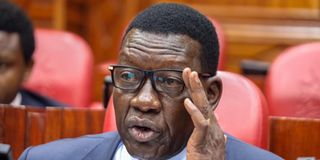Chirchir defends Sh7 fuel levy increase

Roads and Transport Cabinet Secretary Davis Chirchir when he appeared before the Senate Committee on Roads, Transportation and Housing at County Hall, Nairobi on September 13, 2024, to respond to questions on the leasing of the Jomo Kenyatta International Airport to Adani.
The government has defended the move to increase road maintenance levy from by Sh7 per litre of petrol and diesel, saying the country is grappling with at least Sh724 billion in road maintenance backlog.
Roads and Transport Cabinet Secretary Davis Chirchir said Kenya collects a paltry Sh79 billion annually from the current levy, which he said has stagnated since 2016, adding that the backlog can only be addressed by the new levy.
The development comes as the CS said it will take about 15 years to complete all road project commitments which has an outstanding commitment of close to Sh700 billion, including an outstanding bills portfolio of Sh165 billion.
This is informed by the current average net government annual budget ceiling allocations of Sh55 billion committed to road projects.
Appearing before the Senate on Wednesday, the CS said the increment from Sh18 to Sh25 is justified because more funds are needed for maintenance of the road network which has increased by 77,671 kilometres since 2016 when the levy was last reviewed.
He pointed out that Sh157 billion is needed for road maintenance activities for national roads in the fiscal year ending June 30, 2025.
However, the anticipated fuel levy collection for the same financial year is Sh79 billion, leaving a deficit of Sh78 billion.
Collection gaps
CS Chirchir told senators that because of the collection gaps, an unsustainably large financing gap had emerged between the cost of essential road maintenance and the resources collected from the fuel levy by 2024.
He said that because of the above-mentioned funding gap in road maintenance, his ministry has not been able to perform all required maintenance resulting in suspension of award of a number of already tendered maintenance activities due to lack of budget.
“Following from the above situation, a proposal for review of the Road Maintenance Levy by Sh7 from Sh18 to Sh25 per litre was formulated several months ago to partially fill the maintenance gap,” said Mr Chirchir.
“I would not be exaggerating to say that the recent adjustment in the fuel levy rate was a critical, vital and urgent step without which the heavy investment of recent years in building new roads would ultimately prove to be largely in vain,” he added.
The CS explained that the RMLF collections at the current rate of Sh18 per litre has stagnated at about Sh79 billion annually, an amount not able to cater for maintenance of all roads in the country.
Subsequently, the road network has deteriorated over the years due to ageing, increased urbanisation, traffic and effects of climate change.
Mr Chirchir said that to maintain the net present value of 2016, the levy should in fact be at Sh59 per litre of petrol and diesel.
He said Kenya had a road network of 161,451 kilometres in 2016 when the levy was Sh18 but this has grown to 239,122 kilometres, representing a 48 percent growth.
Of the network, 69 percent of the road network is in good and fair condition requiring resources to maintain the condition.
However, 30 percent remain in poor conditions requiring considerable resources to restore them to maintenance condition.
He said the increase will see additional 15,000 kilometres of roads maintained, bringing the total number of roads under maintenance to 55,000 annually.
“In order to effectively address the funding shortfall, it is imperative that the roads maintenance fuel levy order of 2016 be reviewed,” said Mr Chirchir.
“The higher unit costs of construction indicate that for the same type of work in 2016, more funds are required currently. The RMLF rate therefore needs to be adjusted for inflation,” he added.
He said that inflation resulting in higher costs of construction and maintenance of roads over the years, increase in fuel import prices and devaluation of the Kenyan shilling have continued to pile pressure on the funds available for road maintenance resulting in the backlog.
The CS added that the devaluation of the shilling where the shilling to dollar exchanged at Sh101.08 in 2016 against the current exchange rate of Sh135 as of May 2024, means the adjustment should hit Sh24.30 per litre.
“Noting that some materials used in road works are imported, the decline in value of the Kenya shilling means that more funds are required to purchase the same materials,” said the CS.
The CS explained that due to inflation, the current annual RMLF collections are equivalent to Sh52 billion in 2016 and were the real value of RMLF at 2016 to be maintained, annual collections for the financial year ending June 30, 2024 should have been Sh122 billion and not Sh80 billion.
“Based on this rate, the net present value of fuel levy has declined from Sh18 per litre to Sh5.49 per litre of petrol and diesel,” he said.
Nonetheless, the CS said his ministry will propose a legislative adjustment to have part of the fuel levy earmarked for rural roads can be ring-fenced and directly prioritised by Kenya Rural Roads Authority for maintenance of paved and other connector rural roads.
“We believe that the proposed refinement to the management of road maintenance funds for rural roads, should it find favour and approval through the relevant procedures, will be the key to a material improvement in the maintenance of particularly paved rural roads,” he said.





